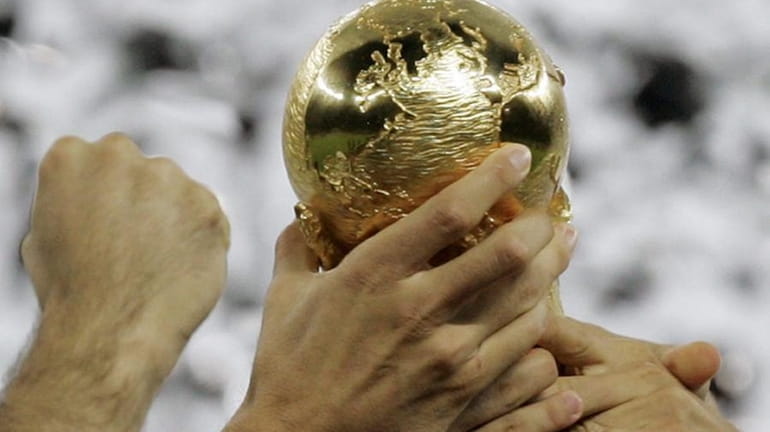1950 upset of England was an American beauty

Italy soccer players grab hold of the World Cup trophy after beating France 5-3 in a penalty kick shootout to win the final of the soccer World Cup between Italy and France. (July 9, 2006) Credit: AP
A certain sports apparel giant has incorporated a diagonal stripe on the U.S. World Cup jerseys, meant to recall the Yanks' mutinous 1-0 World Cup upset of England in 1950.
Perhaps it is by accident that, on the Americans' so-called "home" white shirts, the grayish, shadowy stripe is so pale that it can't be seen from more than a couple of feet. As if the memory, and import, of that 1950 shocker is fading completely away. (On the team's alternate blue shirts, the white stripe is plenty obvious.)
The Yanks, after all, long ago went from soccer nitwits to soccer revolutionaries and legitimate soccer citizens. In Saturday's World Cup rematch, 60 years later, a Colonists' victory over the sport's Mother Country would be noteworthy but hardly unfathomable.
"There's a real possibility that the U.S. could get three points [a victory], and I'd look at that as not a big surprise," said Alexi Lalas, who played on two U.S. World Cup teams before working as a Major League Soccer executive and now as TV analyst. "The U.S. is a whole lot better than most people give them credit for, and England is not that good."
Lalas, it happens, scored a goal on June 9, 1993 in Foxboro when the Americans achieved their only other victory against the English, 2-0. The fact that England has won their other seven meetings not only adds weight to today's World Cup opener but also demands that the events of June 29, 1950 in Belo Horizonte, Brazil not be forgotten after all.
Walter Bahr, 83, one of four surviving members of the Yanks' 1950 team, which lost its other two Cup games to Spain and Brazil, often has noted that "we hadn't even heard of the World Cup until we went and played in it. By the time we got to Brazil, we realized it was a pretty big deal. But at the time, no one knew we left and no one knew we came back."
Just one U.S. reporter, Dent McSkimming of the St. Louis Post-Dispatch, witnessed the England upset - but only because he took vacation time in Brazil. (He once described it "as if Oxford University sent a baseball team over here and beat the Yankees.")
Defender Ed McIlvenny, of Philadelphia, has been described by Bahr as "the closest thing to a professional player we had."
Bahr, later the soccer coach at Penn State, was a schoolteacher then. Haitian-born Joe Gaetjens, who scored the winning goal on an assist from Bahr, worked as a dishwasher in New York City. Defender Harry Keough and midfielder Frank Wallace were mailmen in St. Louis. Goalie Frank Borghi was an undertaker in St. Louis. Belgian-born defender Joe Maca was an interior decorator in New York. Midfielder Charlie Colombo was a St. Louis carpenter and midfielder Gino Pariani a cannery working in St. Louis. Fall River, Mass., residents John Souza and Ed Souza, both forwards but not related, worked as a knitting plant foreman and truck driver, respectively.
One regular member of the team, striker Ben McGloughlin, was told by his boss (he made flow meters) that if he took time off to go to Brazil he no longer would have a job. So he stayed home.
When an Associated Press report of the historic Cup upset ran in The New York Times, it credited the goal to the wrong player. (Newsday did not print a word on either that game or the tournament.)
It did happen, though, an early shot in the U.S. soccer rebellion. By comparison, Saturday's is a game of equals.
